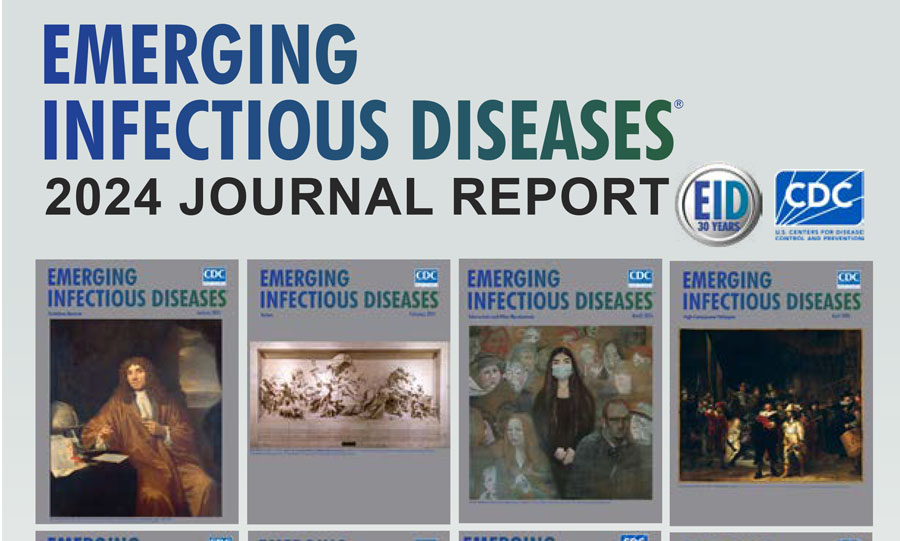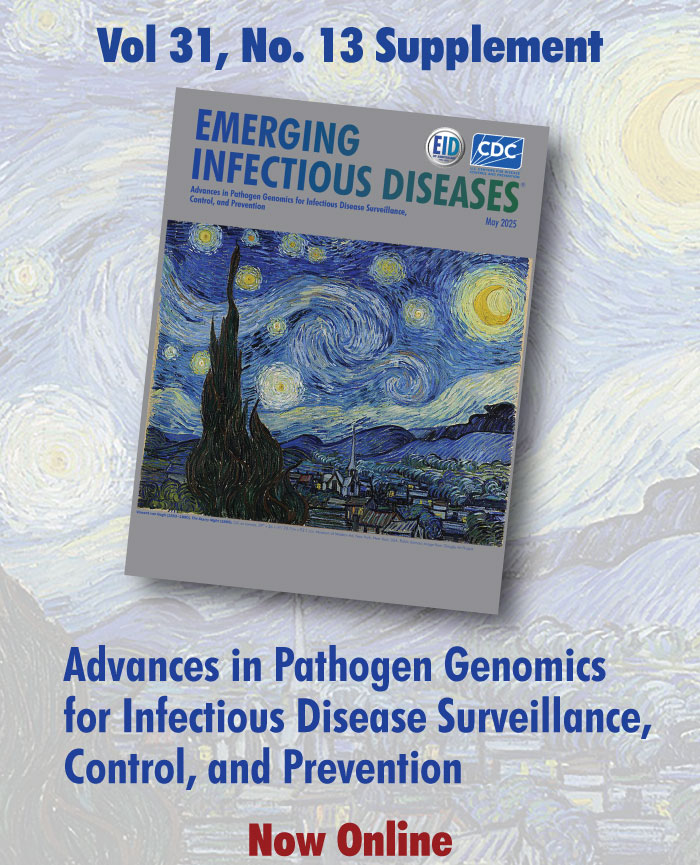Medscape CME Activity
Medscape, LLC is pleased to provide online continuing medical education (CME) for selected journal articles, allowing clinicians the opportunity to earn CME credit. In support of improving patient care, these activities have been planned and implemented by Medscape, LLC and Emerging Infectious Diseases. Medscape, LLC is jointly accredited by the Accreditation Council for Continuing Medical Education (ACCME), the Accreditation Council for Pharmacy Education (ACPE), and the American Nurses Credentialing Center (ANCC), to provide continuing education for the healthcare team.
CME credit is available for one year after publication.
Volume 18—2012
Volume 18, Number 12—December 2012
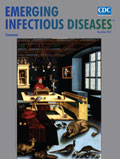
We prospectively studied 3,791 children hospitalized during 2011 during a large outbreak of enterovirus 71–associated hand, foot, and mouth disease in Vietnam. Formal assessment of public health interventions, use of intravenous immunoglobulin and other therapies, and factors predisposing for progression of disease is needed to improve clinical management.
| EID | Khanh T, Sabanathan S, Thanh T, Thoa L, Thuong T, Hang V, et al. Enterovirus 71–associated Hand, Foot, and Mouth Disease, Southern Vietnam, 2011. Emerg Infect Dis. 2012;18(12):2002-2005. https://doi.org/10.3201/eid1812.120929 |
|---|---|
| AMA | Khanh T, Sabanathan S, Thanh T, et al. Enterovirus 71–associated Hand, Foot, and Mouth Disease, Southern Vietnam, 2011. Emerging Infectious Diseases. 2012;18(12):2002-2005. doi:10.3201/eid1812.120929. |
| APA | Khanh, T., Sabanathan, S., Thanh, T., Thoa, L., Thuong, T., Hang, V....van Doorn, H. (2012). Enterovirus 71–associated Hand, Foot, and Mouth Disease, Southern Vietnam, 2011. Emerging Infectious Diseases, 18(12), 2002-2005. https://doi.org/10.3201/eid1812.120929. |
Salmonellosis is usually associated with foodborne transmission. To identify risk from animal contact, we compared animal exposures of case-patients infected with bovine-associated Salmonella subtypes with those of control-patients infected with non-bovine–associated subtypes. We used data collected in New York and Washington, USA, from March 1, 2008, through March 1, 2010. Contact with farm animals during the 5 days before illness onset was significantly associated with being a case-patient (odds ratio 3.2, p = 0.0008), after consumption of undercooked ground beef and unpasteurized milk were controlled for. Contact with cattle specifically was also significantly associated with being a case-patient (odds ratio 7.4, p = 0.0002), after food exposures were controlled for. More cases of bovine-associated salmonellosis in humans might result from direct contact with cattle, as opposed to ingestion of foods of bovine origin, than previously recognized. Efforts to control salmonellosis should include a focus on transmission routes other than foodborne.
| EID | Cummings KJ, Warnick LD, Davis MA, Eckmann K, Gröhn YT, Hoelzer K, et al. Farm Animal Contact as Risk Factor for Transmission of Bovine-associated Salmonella Subtypes. Emerg Infect Dis. 2012;18(12):1929-1936. https://doi.org/10.3201/eid1812.110831 |
|---|---|
| AMA | Cummings KJ, Warnick LD, Davis MA, et al. Farm Animal Contact as Risk Factor for Transmission of Bovine-associated Salmonella Subtypes. Emerging Infectious Diseases. 2012;18(12):1929-1936. doi:10.3201/eid1812.110831. |
| APA | Cummings, K. J., Warnick, L. D., Davis, M. A., Eckmann, K., Gröhn, Y. T., Hoelzer, K....Besser, T. E. (2012). Farm Animal Contact as Risk Factor for Transmission of Bovine-associated Salmonella Subtypes. Emerging Infectious Diseases, 18(12), 1929-1936. https://doi.org/10.3201/eid1812.110831. |
Volume 18, Number 11—November 2012
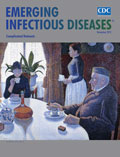
Coccidioidomycosis is endemic to the Americas; however, data on deaths caused by this disease are limited. To determine the rate of coccidioidomycosis-associated deaths in the United States, we examined multiple cause–coded death records for 1990–2008 for demographics, secular trends, and geographic distribution. Deaths were identified by International Classification of Diseases, 9th and 10th Revision, codes, and mortality rates were calculated. Associations of deaths among persons with selected concurrent conditions were examined and compared with deaths among a control group who did not have coccidioidomycosis. During the 18-year period, 3,089 coccidioidomycosis-associated deaths occurred among US residents. The overall age-adjusted mortality rate was 0.59 per 1 million person-years; 55,264 potential life-years were lost. Those at highest risk for death were men, persons >65 years, Hispanics, Native Americans, and residents of California or Arizona. Common concurrent conditions were HIV and other immunosuppressive conditions. The number of deaths from coccidioidomycosis might be greater than currently appreciated.
| EID | Huang JY, Bristow B, Shafir S, Sorvillo F. Coccidioidomycosis-associated Deaths, United States, 1990–2008. Emerg Infect Dis. 2012;18(11):1723-1728. https://doi.org/10.3201/eid1811.120752 |
|---|---|
| AMA | Huang JY, Bristow B, Shafir S, et al. Coccidioidomycosis-associated Deaths, United States, 1990–2008. Emerging Infectious Diseases. 2012;18(11):1723-1728. doi:10.3201/eid1811.120752. |
| APA | Huang, J. Y., Bristow, B., Shafir, S., & Sorvillo, F. (2012). Coccidioidomycosis-associated Deaths, United States, 1990–2008. Emerging Infectious Diseases, 18(11), 1723-1728. https://doi.org/10.3201/eid1811.120752. |
In the Netherlands, the national immunization program includes 7-valent pneumococcal conjugate vaccine (PCV7) for all newborns born after April 1, 2006. We compared the incidence of invasive pneumococcal disease (IPD) and patient and disease characteristics before PCV7 introduction (June 2004–June 2006) with those after PCV7 introduction (June 2008–June 2010). Culture-confirmed IPD cases were identified by 9 sentinel laboratories covering ≈25% of the Dutch population. Significant declines in overall IPD incidence were observed in children <2 (60%) and in persons >65 (13%) years of age. A trend toward gradual increases in non–PCV7 serotype IPD infections was observed in all age groups; the largest increases were among persons 50–64 (37%) and >65 (25%) years of age. In adults, the proportion of immunocompromised persons increased among IPD patients. Overall, deaths from IPD decreased from 16% to 12% because of a lower case-fatality rate for persons with non–PCV7 serotype IPD.
| EID | van Deursen A, van Mens SP, Sanders E, Vlaminckx B, de Melker HE, Schouls LM, et al. Invasive Pneumococcal Disease and 7-Valent Pneumococcal Conjugate Vaccine, the Netherlands. Emerg Infect Dis. 2012;18(11):1729-1737. https://doi.org/10.3201/eid1811.120329 |
|---|---|
| AMA | van Deursen A, van Mens SP, Sanders E, et al. Invasive Pneumococcal Disease and 7-Valent Pneumococcal Conjugate Vaccine, the Netherlands. Emerging Infectious Diseases. 2012;18(11):1729-1737. doi:10.3201/eid1811.120329. |
| APA | van Deursen, A., van Mens, S. P., Sanders, E., Vlaminckx, B., de Melker, H. E., Schouls, L. M....van der Ende, A. (2012). Invasive Pneumococcal Disease and 7-Valent Pneumococcal Conjugate Vaccine, the Netherlands. Emerging Infectious Diseases, 18(11), 1729-1737. https://doi.org/10.3201/eid1811.120329. |
Antimicrobial treatments and vaccines can alter bacterial interactions in the nasopharynx, thereby altering disease processes. To better understand these interactions, we examined colonization rates of 3 respiratory bacterial pathogens among 320 children when healthy and at onset of acute otitis media (AOM). Bacterial interactions were analyzed with a repeated measures logistic regression model. Among healthy children, Streptococcus pneumoniae and Moraxella catarrhalis were synergistically (positively) associated. Colonization with S. pneumoniae when healthy, but not at onset of AOM, was competitively (negatively) associated with Staphylococcus aureus. Among children with AOM, competitive associations were found between Haemophilus influenzae and S. pneumoniae and between H. influenzae and M. catarrhalis; rates of colonization with H. influenzae were higher. Bacterial interactions result in differing pathogen prevalence during periods of health and at onset of AOM. H. influenzae might become a more common cause of AOM among children who receive pneumococcal conjugate vaccine.
| EID | Xu Q, Almudervar A, Casey JR, Pichichero ME. Nasopharyngeal Bacterial Interactions in Children. Emerg Infect Dis. 2012;18(11):1738-1745. https://doi.org/10.3201/eid1811.111904 |
|---|---|
| AMA | Xu Q, Almudervar A, Casey JR, et al. Nasopharyngeal Bacterial Interactions in Children. Emerging Infectious Diseases. 2012;18(11):1738-1745. doi:10.3201/eid1811.111904. |
| APA | Xu, Q., Almudervar, A., Casey, J. R., & Pichichero, M. E. (2012). Nasopharyngeal Bacterial Interactions in Children. Emerging Infectious Diseases, 18(11), 1738-1745. https://doi.org/10.3201/eid1811.111904. |
Volume 18, Number 10—October 2012
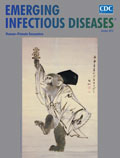
Noroviruses are the leading cause of foodborne illness in the United States. To better guide interventions, we analyzed 2,922 foodborne disease outbreaks for which norovirus was the suspected or confirmed cause, which had been reported to the Foodborne Disease Outbreak Surveillance System of the Centers for Disease Control and Prevention during 2001–2008. On average, 365 foodborne norovirus outbreaks were reported annually, resulting in an estimated 10,324 illnesses, 1,247 health care provider visits, 156 hospitalizations, and 1 death. In 364 outbreaks attributed to a single commodity, leafy vegetables (33%), fruits/nuts (16%), and mollusks (13%) were implicated most commonly. Infected food handlers were the source of 53% of outbreaks and may have contributed to 82% of outbreaks. Most foods were likely contaminated during preparation and service, except for mollusks, and occasionally, produce was contaminated during production and processing. Interventions to reduce the frequency of foodborne norovirus outbreaks should focus on food workers and production of produce and shellfish.
| EID | Hall AJ, Eisenbart VG, Etingüe A, Gould L, Lopman BA, Parashar UD. Epidemiology of Foodborne Norovirus Outbreaks, United States, 2001–2008. Emerg Infect Dis. 2012;18(10):1566-1573. https://doi.org/10.3201/eid1810.120833 |
|---|---|
| AMA | Hall AJ, Eisenbart VG, Etingüe A, et al. Epidemiology of Foodborne Norovirus Outbreaks, United States, 2001–2008. Emerging Infectious Diseases. 2012;18(10):1566-1573. doi:10.3201/eid1810.120833. |
| APA | Hall, A. J., Eisenbart, V. G., Etingüe, A., Gould, L., Lopman, B. A., & Parashar, U. D. (2012). Epidemiology of Foodborne Norovirus Outbreaks, United States, 2001–2008. Emerging Infectious Diseases, 18(10), 1566-1573. https://doi.org/10.3201/eid1810.120833. |
Methicillin-resistant Staphylococcus aureus (MRSA) is a human pathogen that has diverse molecular heterogeneity. Most MRSA strains in the United States are pulsed-field gel electrophoresis USA100 sequence type (ST) 5 and USA300 ST8. Infections with MRSA ST239-III are common and found during health care–associated outbreaks. However, this strain has been rarely reported in the United States. As part of a study supported by the Prevention Epicenter Program of the Centers for Disease Control and Prevention (Atlanta, GA, USA), which evaluated transmission of MRSA among hospitals in Ohio, molecular typing identified 78 (6%) of 1,286 patients with MRSA ST239-III infections. Ninety-five percent (74/78) of these infections were health care associated, and 65% (51/78) of patients had histories of invasive device use. The crude case-fatality rate was 22% (17/78). Identification of these strains, which belong to a virulent clonal group, emphasizes the need for molecular surveillance.
| EID | Wang S, Khan Y, Hines L, Mediavilla JR, Zhang L, Chen L, et al. Methicillin-Resistant Staphylococcus aureus Sequence Type 239-III, Ohio, USA, 2007–2009. Emerg Infect Dis. 2012;18(10):1557-1565. https://doi.org/10.3201/eid1810.120468 |
|---|---|
| AMA | Wang S, Khan Y, Hines L, et al. Methicillin-Resistant Staphylococcus aureus Sequence Type 239-III, Ohio, USA, 2007–2009. Emerging Infectious Diseases. 2012;18(10):1557-1565. doi:10.3201/eid1810.120468. |
| APA | Wang, S., Khan, Y., Hines, L., Mediavilla, J. R., Zhang, L., Chen, L....Stevenson, K. B. (2012). Methicillin-Resistant Staphylococcus aureus Sequence Type 239-III, Ohio, USA, 2007–2009. Emerging Infectious Diseases, 18(10), 1557-1565. https://doi.org/10.3201/eid1810.120468. |
Volume 18, Number 9—September 2012

Fluoroquinolone antimicrobial drugs are highly bioavailable, broad-spectrum agents with activity against gram-negative pathogens, especially those resistant to other classes of antimicrobial drugs. Australia has restricted the use of quinolones in humans through its national pharmaceutical subsidy scheme; and, through regulation, has not permitted the use of quinolones in food-producing animals. As a consequence, resistance to fluoroquinolones in the community has been slow to emerge and has remained at low levels in key pathogens, such as Escherichia coli. In contrast to policies in most other countries, this policy has successfully preserved the utility of this class of antimicrobial drugs for treatment of most infections.
| EID | Cheng AC, Turnidge J, Collignon P, Looke D, Barton M, Gottlieb T. Control of Fluoroquinolone Resistance through Successful Regulation, Australia. Emerg Infect Dis. 2012;18(9):1453-1460. https://doi.org/10.3201/eid1809.111515 |
|---|---|
| AMA | Cheng AC, Turnidge J, Collignon P, et al. Control of Fluoroquinolone Resistance through Successful Regulation, Australia. Emerging Infectious Diseases. 2012;18(9):1453-1460. doi:10.3201/eid1809.111515. |
| APA | Cheng, A. C., Turnidge, J., Collignon, P., Looke, D., Barton, M., & Gottlieb, T. (2012). Control of Fluoroquinolone Resistance through Successful Regulation, Australia. Emerging Infectious Diseases, 18(9), 1453-1460. https://doi.org/10.3201/eid1809.111515. |
Despite high vaccination coverage in most European countries, large community outbreaks of measles do occur, normally clustered around schools and resulting from suboptimal vaccination coverage. To determine whether or when it is worth implementing outbreak-response vaccination campaigns in schools, we used stochastic outbreak models to reproduce a public school outbreak in Germany, where no vaccination campaign was implemented. We assumed 2 scenarios covering the baseline vaccination ratio range (91.3%–94.3%) estimated for that school and computed outbreaks assuming various vaccination delays. In one scenario, reacting (i.e., implementing outbreak-response vaccination campaigns) within 12–24 days avoided large outbreaks and reacting within 50 days reduced outbreak size. In the other scenario, reacting within 6–14 days avoided large outbreaks and reacting within 40 days reduced the outbreak size. These are realistic time frames for implementing school outbreak response vaccination campaigns. High baseline vaccination ratios extended the time needed for effective response.
| EID | Marinović A, Swaan C, Wichmann O, van Steenbergen J, Kretzschmar M. Effectiveness and Timing of Vaccination during School Measles Outbreak. Emerg Infect Dis. 2012;18(9):1405-1413. https://doi.org/10.3201/eid1809.111578 |
|---|---|
| AMA | Marinović A, Swaan C, Wichmann O, et al. Effectiveness and Timing of Vaccination during School Measles Outbreak. Emerging Infectious Diseases. 2012;18(9):1405-1413. doi:10.3201/eid1809.111578. |
| APA | Marinović, A., Swaan, C., Wichmann, O., van Steenbergen, J., & Kretzschmar, M. (2012). Effectiveness and Timing of Vaccination during School Measles Outbreak. Emerging Infectious Diseases, 18(9), 1405-1413. https://doi.org/10.3201/eid1809.111578. |
To assess adherence to real-time changes in guidelines for influenza diagnosis and use of oseltamivir during the 2009 influenza A(H1N1) pandemic, we reviewed medical records of patients with confirmed or suspected influenza-like illness (ILI) and those with no viral testing in a large Los Angeles (California, USA) hospital. Of 882 tested patients, 178 had results positive for influenza; 136 of the remaining patients received oseltamivir despite negative or no results. Oseltamivir use was consistent with national recommendations in >90%. Of inpatients, children were less likely than adults to have ILI at testing and to receive oseltamivir if ILI was found. Of outpatients, children were more likely to have positive test results; 20% tested did not have ILI or other influenza signs and symptoms. Twenty-five of 96 test-positive patients and 13 of 19 with lower respiratory tract disease were, inappropriately, not treated. Variations between practice and national recommendations could inform clinical education in future influenza seasons.
| EID | Vijayan V, Jing J, Zangwill KM. Evaluation of Diagnostic and Therapeutic Approaches for Suspected Influenza A(H1N1)pdm09 Infection, 2009–2010. Emerg Infect Dis. 2012;18(9):1414-1421. https://doi.org/10.3201/eid1809.111564 |
|---|---|
| AMA | Vijayan V, Jing J, Zangwill KM. Evaluation of Diagnostic and Therapeutic Approaches for Suspected Influenza A(H1N1)pdm09 Infection, 2009–2010. Emerging Infectious Diseases. 2012;18(9):1414-1421. doi:10.3201/eid1809.111564. |
| APA | Vijayan, V., Jing, J., & Zangwill, K. M. (2012). Evaluation of Diagnostic and Therapeutic Approaches for Suspected Influenza A(H1N1)pdm09 Infection, 2009–2010. Emerging Infectious Diseases, 18(9), 1414-1421. https://doi.org/10.3201/eid1809.111564. |
Volume 18, Number 8—August 2012
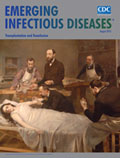
Health care workers (HCWs) may transmit respiratory infection to patients. We assessed evidence for the effectiveness of vaccinating HCWs to provide indirect protection for patients at risk for severe or complicated disease after acute respiratory infection. We searched electronic health care databases and sources of gray literature by using a predefined strategy. Risk for bias was assessed by using validated tools, and results were synthesized by using a narrative approach. Seventeen of the 12,352 identified citations met the full inclusion criteria, and 3 additional articles were identified from reference or citation tracking. All considered influenza vaccination of HCWs, and most were conducted in long-term residential care settings. Consistency in the direction of effect was observed across several different outcome measures, suggesting a likely protective effect for patients in residential care settings. However, evidence was insufficient for us to confidently extrapolate this to other at-risk patient groups.
| EID | Dolan GP, Harris RM, Clarkson M, Sokal R, Morgan G, Mukaigawara M, et al. Vaccination of Health Care Workers to Protect Patients at Increased Risk for Acute Respiratory Disease. Emerg Infect Dis. 2012;18(8):1225-1234. https://doi.org/10.3201/eid1808.111355 |
|---|---|
| AMA | Dolan GP, Harris RM, Clarkson M, et al. Vaccination of Health Care Workers to Protect Patients at Increased Risk for Acute Respiratory Disease. Emerging Infectious Diseases. 2012;18(8):1225-1234. doi:10.3201/eid1808.111355. |
| APA | Dolan, G. P., Harris, R. M., Clarkson, M., Sokal, R., Morgan, G., Mukaigawara, M....Nguyen-Van-Tam, J. S. (2012). Vaccination of Health Care Workers to Protect Patients at Increased Risk for Acute Respiratory Disease. Emerging Infectious Diseases, 18(8), 1225-1234. https://doi.org/10.3201/eid1808.111355. |
Paragonimiasis is an infection caused by lung flukes of the genus Paragonimus. In Asia, P. westermani infections are relatively common because of dietary practices. However, in North America, cases of paragonimiasis, which are caused by P. kellicotti flukes, are rare. Only 7 autochthonous cases of paragonimiasis were reported during 1968–2008. In 2009, we reported 3 new case-patients with paragonimiasis who had been seen at our medical center over an 18-month period. Six additional case-patients were identified in St. Louis, Missouri, USA, and treated at Washington University–affiliated health centers in 2009–2010. We report detailed descriptions of these case-patients, which includes unusual clinical manifestations. We also describe public health interventions that were undertaken to inform the general public and physicians about the disease and its mode of transmission.
| EID | Lane MA, Marcos LA, Onen NF, Demertzis LM, Hayes EV, Davila SZ, et al. Paragonimus kellicotti Flukes in Missouri, USA. Emerg Infect Dis. 2012;18(8):1263-1267. https://doi.org/10.3201/eid1808.120335 |
|---|---|
| AMA | Lane MA, Marcos LA, Onen NF, et al. Paragonimus kellicotti Flukes in Missouri, USA. Emerging Infectious Diseases. 2012;18(8):1263-1267. doi:10.3201/eid1808.120335. |
| APA | Lane, M. A., Marcos, L. A., Onen, N. F., Demertzis, L. M., Hayes, E. V., Davila, S. Z....Weil, G. J. (2012). Paragonimus kellicotti Flukes in Missouri, USA. Emerging Infectious Diseases, 18(8), 1263-1267. https://doi.org/10.3201/eid1808.120335. |
Using data from the Gonococcal Isolate Surveillance Project, we studied changes in ciprofloxacin resistance in Neisseria gonorrhoeae isolates in the United States during 2002–2007. Compared with prevalence in heterosexual men, prevalence of ciprofloxacin-resistant N. gonorrhoeae infections showed a more pronounced increase in men who have sex with men (MSM), particularly through an increase in prevalence of strains also resistant to tetracycline and penicillin. Moreover, that multidrug resistance profile among MSM was negatively associated with recent travel. Across the surveillance project sites, first appearance of ciprofloxacin resistance in heterosexual men was positively correlated with such resistance for MSM. The increase in prevalence of ciprofloxacin resistance may have been facilitated by use of fluoroquinolones for treating gonorrhea and other conditions. The prominence of multidrug resistance suggests that using other classes of antimicrobial drugs for purposes other than treating gonorrhea helped increase the prevalence of ciprofloxacin-resistant strains that are also resistant to those drugs.
| EID | Goldstein E, Kirkcaldy RD, Reshef D, Berman S, Weinstock H, Sabeti P, et al. Factors Related to Increasing Prevalence of Resistance to Ciprofloxacin and Other Antimicrobial Drugs in Neisseria gonorrhoeae, United States. Emerg Infect Dis. 2012;18(8):1290-1297. https://doi.org/10.3201/eid1808.111202 |
|---|---|
| AMA | Goldstein E, Kirkcaldy RD, Reshef D, et al. Factors Related to Increasing Prevalence of Resistance to Ciprofloxacin and Other Antimicrobial Drugs in Neisseria gonorrhoeae, United States. Emerging Infectious Diseases. 2012;18(8):1290-1297. doi:10.3201/eid1808.111202. |
| APA | Goldstein, E., Kirkcaldy, R. D., Reshef, D., Berman, S., Weinstock, H., Sabeti, P....Lipsitch, M. (2012). Factors Related to Increasing Prevalence of Resistance to Ciprofloxacin and Other Antimicrobial Drugs in Neisseria gonorrhoeae, United States. Emerging Infectious Diseases, 18(8), 1290-1297. https://doi.org/10.3201/eid1808.111202. |
Volume 18, Number 7—July 2012

Under the current International Health Regulations, 194 states parties are obligated to report potential public health emergencies of international concern to the World Health Organization (WHO) within 72 hours of becoming aware of an event. During July 2007–December 2011, WHO assessed and posted on a secure web portal 222 events from 105 states parties, including 24 events from the United States. Twelve US events involved human influenza caused by a new virus subtype, including the first report of influenza A(H1N1)pdm09 virus, which constitutes the only public health emergency of international concern determined by the WHO director-general to date. Additional US events involved 5 Salmonella spp. outbreaks, botulism, Escherichia coli O157:H7 infections, Guillain-Barré syndrome, contaminated heparin, Lassa fever, an oil spill, and typhoid fever. Rapid information exchange among WHO and member states facilitated by the International Health Regulations leads to better situation awareness of emerging threats and enables a more coordinated and transparent global response.
| EID | Kohl KS, Arthur RR, O’Connor R, Fernandez J. Assessment of Public Health Events through International Health Regulations, United States, 2007–2011. Emerg Infect Dis. 2012;18(7):1047-1053. https://doi.org/10.3201/eid1807.120231 |
|---|---|
| AMA | Kohl KS, Arthur RR, O’Connor R, et al. Assessment of Public Health Events through International Health Regulations, United States, 2007–2011. Emerging Infectious Diseases. 2012;18(7):1047-1053. doi:10.3201/eid1807.120231. |
| APA | Kohl, K. S., Arthur, R. R., O’Connor, R., & Fernandez, J. (2012). Assessment of Public Health Events through International Health Regulations, United States, 2007–2011. Emerging Infectious Diseases, 18(7), 1047-1053. https://doi.org/10.3201/eid1807.120231. |
In 2003, infection with low pathogenic avian influenza A (H7N2) virus was identified in an immunocompromised man with fever and community-acquired pneumonia in New York, USA. The patient recovered. Although the source of the virus was not identified, this case indicates the usefulness of virus culture for detecting novel influenza A viruses.
| EID | Ostrowsky B, Huang A, Terry W, Anton D, Brunagel B, Traynor L, et al. Low Pathogenic Avian Influenza A (H7N2) Virus Infection in Immunocompromised Adult, New York, USA, 2003. Emerg Infect Dis. 2012;18(7):1128-1131. https://doi.org/10.3201/eid1807.111913 |
|---|---|
| AMA | Ostrowsky B, Huang A, Terry W, et al. Low Pathogenic Avian Influenza A (H7N2) Virus Infection in Immunocompromised Adult, New York, USA, 2003. Emerging Infectious Diseases. 2012;18(7):1128-1131. doi:10.3201/eid1807.111913. |
| APA | Ostrowsky, B., Huang, A., Terry, W., Anton, D., Brunagel, B., Traynor, L....Uyeki, T. M. (2012). Low Pathogenic Avian Influenza A (H7N2) Virus Infection in Immunocompromised Adult, New York, USA, 2003. Emerging Infectious Diseases, 18(7), 1128-1131. https://doi.org/10.3201/eid1807.111913. |
Volume 18, Number 6—June 2012
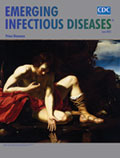
Extended-spectrum β-lactamase–producing Enterobacteriaceae isolates (ESBLE) are emerging pathogens that confer resistance to antimicrobial drugs. We conducted a 10-year study in France (January 2001–April 2010) to investigate the incidence of and risk factors for ESBLE infections after liver transplant. Of 710 transplant patients screened preoperatively for ESBLE fecal carriage, 5.5% had ESBLE infection develop within 4 months after surgery; patients with pretransplant ESBLE fecal carriage were more likely to have infection develop than were noncarriers. Typing showed extensive genetic diversity, with a large predominance of CTX-M enzymes. Independent predictors of ESBLE infection were pretransplant fecal carriage, Model for End Stage Liver Disease score >25, and return to surgery. Our results indicate that the influx of preoperatively acquired ESBLE isolates into the hospital outweighs cross-transmission in the epidemiology of ESBLE infections after liver transplant. Transplant candidates should be systematically screened for carriage, and posttransplant infection in carriers should be treated with carbapenems.
| EID | Bert F, Larroque B, Paugam-Burtz C, Dondero F, Durand F, Marcon E, et al. Pretransplant Fecal Carriage of Extended-Spectrum β-Lactamase–producing Enterobacteriaceae and Infection after Liver Transplant, France. Emerg Infect Dis. 2012;18(6):908-916. https://doi.org/10.3201/eid1806.110139 |
|---|---|
| AMA | Bert F, Larroque B, Paugam-Burtz C, et al. Pretransplant Fecal Carriage of Extended-Spectrum β-Lactamase–producing Enterobacteriaceae and Infection after Liver Transplant, France. Emerging Infectious Diseases. 2012;18(6):908-916. doi:10.3201/eid1806.110139. |
| APA | Bert, F., Larroque, B., Paugam-Burtz, C., Dondero, F., Durand, F., Marcon, E....Nicolas-Chanoine, M. (2012). Pretransplant Fecal Carriage of Extended-Spectrum β-Lactamase–producing Enterobacteriaceae and Infection after Liver Transplant, France. Emerging Infectious Diseases, 18(6), 908-916. https://doi.org/10.3201/eid1806.110139. |
The era of iatrogenic Creutzfeldt-Jakob disease (CJD) has nearly closed; only occasional cases with exceptionally long incubation periods are still appearing. The principal sources of these outbreaks are contaminated growth hormone (226 cases) and dura mater grafts (228 cases) derived from human cadavers with undiagnosed CJD infections; a small number of additional cases are caused by neurosurgical instrument contamination, corneal grafts, gonadotrophic hormone, and secondary infection with variant CJD transmitted by transfusion of blood products. No new sources of disease have been identified, and current practices, which combine improved recognition of potentially infected persons with new disinfection methods for fragile surgical instruments and biological products, should continue to minimize the risk for iatrogenic disease until a blood screening test for the detection of preclinical infection is validated for human use.
| EID | Brown P, Brandel J, Sato T, Nakamura Y, MacKenzie J, Will RG, et al. Iatrogenic Creutzfeldt-Jakob Disease, Final Assessment. Emerg Infect Dis. 2012;18(6):901-907. https://doi.org/10.3201/eid1806.120116 |
|---|---|
| AMA | Brown P, Brandel J, Sato T, et al. Iatrogenic Creutzfeldt-Jakob Disease, Final Assessment. Emerging Infectious Diseases. 2012;18(6):901-907. doi:10.3201/eid1806.120116. |
| APA | Brown, P., Brandel, J., Sato, T., Nakamura, Y., MacKenzie, J., Will, R. G....Schonberger, L. B. (2012). Iatrogenic Creutzfeldt-Jakob Disease, Final Assessment. Emerging Infectious Diseases, 18(6), 901-907. https://doi.org/10.3201/eid1806.120116. |
We examined trends in incidence of methicillin-resistant Staphylococcus aureus (MRSA) infections in Connecticut, with emphasis on 2007–2010, after legislation required reporting of hospital infections. A case was defined as isolation of MRSA from normally sterile body sites, classified after medical record review as hospital onset (HO), community onset, health care–associated community onset (HACO), or community-associated (CA). Blood isolates collected during 2005–2010 were typed and categorized as community- or health care–related strains. During 2001–2010, a total of 8,758 cases were reported (58% HACO, 31% HO, and 11% CA), and MRSA incidence decreased (p<0.05) for HACO and HO, but increased for CA. Significant 3- to 4-year period trends were decreases in all MRSA (–18.8%), HACO (–12.8%), HO (–33.2%), and CA (–12.7%) infections during 2007–2010, and an increase in CA infections during 2004–2006. Decreases in health care–related isolates accounted for all reductions. Hospital infections reporting may have catalyzed the decreases.
| EID | Hadler JL, Petit S, Mandour M, Cartter ML. Trends in Invasive Infection with Methicillin-Resistant Staphylococcus aureus, Connecticut, USA, 2001–2010. Emerg Infect Dis. 2012;18(6):917-924. https://doi.org/10.3201/eid1806.120182 |
|---|---|
| AMA | Hadler JL, Petit S, Mandour M, et al. Trends in Invasive Infection with Methicillin-Resistant Staphylococcus aureus, Connecticut, USA, 2001–2010. Emerging Infectious Diseases. 2012;18(6):917-924. doi:10.3201/eid1806.120182. |
| APA | Hadler, J. L., Petit, S., Mandour, M., & Cartter, M. L. (2012). Trends in Invasive Infection with Methicillin-Resistant Staphylococcus aureus, Connecticut, USA, 2001–2010. Emerging Infectious Diseases, 18(6), 917-924. https://doi.org/10.3201/eid1806.120182. |
Volume 18, Number 5—May 2012
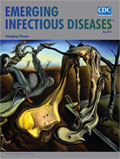
We determined yearly change in prevalence and risk factors for amebic colitis caused by intestinal invasive amebiasis among persons who underwent endoscopy and assessed differences between HIV-positive and HIV-negative persons in Japan. A total of 10,930 patients were selected for analysis, of whom 54 had amebic colitis. Prevalence was in 2009 (0.88%, 12/1360) compared with 2003 (0.16%, 3/1904). Male sex (odds ratio [OR] 8.39, 95% CI 1.99–35.40), age <50 years (OR 4.73, 95% CI 2.43–9.20), history of syphilis (OR 2.90, 95% CI 1.40–5.99), and HIV infection (OR 15.85, 95% CI 7.93–31.70) were independent risk factors. No differences in risk factors were identified between HIV-positive and HIV-negative patients. Contact with commercial sex workers was a new risk factor among HIV-negative patients. Homosexual intercourse, rather than immunosuppressed status, appears to be a risk factor among HIV-positive patients.
| EID | Nagata N, Shimbo T, Akiyama J, Nakashima R, Nishimura S, Yada T, et al. Risk Factors for Intestinal Invasive Amebiasis in Japan, 2003–2009. Emerg Infect Dis. 2012;18(5):717-724. https://doi.org/10.3201/eid1805.111275 |
|---|---|
| AMA | Nagata N, Shimbo T, Akiyama J, et al. Risk Factors for Intestinal Invasive Amebiasis in Japan, 2003–2009. Emerging Infectious Diseases. 2012;18(5):717-724. doi:10.3201/eid1805.111275. |
| APA | Nagata, N., Shimbo, T., Akiyama, J., Nakashima, R., Nishimura, S., Yada, T....Uemura, N. (2012). Risk Factors for Intestinal Invasive Amebiasis in Japan, 2003–2009. Emerging Infectious Diseases, 18(5), 717-724. https://doi.org/10.3201/eid1805.111275. |
Haemophilus influenzae infection causes serious invasive disease, but incidence of the most virulent serotype, Hib, has dropped since introduction of routine Hib vaccination. In England and Wales, the incidence of 2 other serotypes, Hie and Hif, is increasing; during 2001–2010, there was an 11.0% year-on-year increase in Hif and a 7.4% increase in Hie. In 2009–2010, Hif incidence was 0.090/100,000 persons and Hie incidence 0.030/100,000, with higher rates among infants and older adults. Hie had a more severe clinical course; although outcome at 6 months was comparable for the 2 serotypes, case-fatality rate within 7 days of diagnosis was higher for Hie, even after adjustment for age and comorbidities. Multilocus sequence typing revealed a single major circulating clone for both Hif (sequence type 124; 89/99 isolates, 90%) and Hie (sequence type 18; 21/33, 64%), but no association between type and clinical disease or outcome was found.
| EID | Ladhani SN, Collins S, Vickers A, Litt DJ, Crawford C, Ramsay ME, et al. Invasive Haemophilus influenzae Serotype e and f Disease, England and Wales. Emerg Infect Dis. 2012;18(5):725-732. https://doi.org/10.3201/eid1805.111738 |
|---|---|
| AMA | Ladhani SN, Collins S, Vickers A, et al. Invasive Haemophilus influenzae Serotype e and f Disease, England and Wales. Emerging Infectious Diseases. 2012;18(5):725-732. doi:10.3201/eid1805.111738. |
| APA | Ladhani, S. N., Collins, S., Vickers, A., Litt, D. J., Crawford, C., Ramsay, M. E....Slack, M. (2012). Invasive Haemophilus influenzae Serotype e and f Disease, England and Wales. Emerging Infectious Diseases, 18(5), 725-732. https://doi.org/10.3201/eid1805.111738. |
Volume 18, Number 4—April 2012
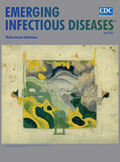
We analyzed US multiple cause-of-death data for 2003–2006 for demographic and clinical determinants for autopsy in unexplained deaths possibly resulting from infectious causes. For 96,242 deaths, the definition for unexplained death was met and autopsy status was recorded. Most decedents were male, 40–49 years of age, and white. To identify factors associated with unexplained death, we used data from Arizona records. Multivariate analysis of Arizona records suggested that decedents of races other than white and black and decedents who had clinicopathologic syndromes in the cardiovascular, sepsis/shock, and multisyndrome categories recorded on the death certificate were least likely to have undergone autopsy; children with unexplained death were the most likely to have undergone autopsy. Improved understanding of unexplained deaths can provide opportunities for further studies, strengthen collaboration between investigators of unexplained deaths, and improve knowledge and awareness of infectious diseases of public health concern.
| EID | Liu L, Callinan LS, Holman RC, Blau DM. Determinants for Autopsy after Unexplained Deaths Possibly Resulting from Infectious Causes, United States. Emerg Infect Dis. 2012;18(4):549-555. https://doi.org/10.3201/eid1804.111311 |
|---|---|
| AMA | Liu L, Callinan LS, Holman RC, et al. Determinants for Autopsy after Unexplained Deaths Possibly Resulting from Infectious Causes, United States. Emerging Infectious Diseases. 2012;18(4):549-555. doi:10.3201/eid1804.111311. |
| APA | Liu, L., Callinan, L. S., Holman, R. C., & Blau, D. M. (2012). Determinants for Autopsy after Unexplained Deaths Possibly Resulting from Infectious Causes, United States. Emerging Infectious Diseases, 18(4), 549-555. https://doi.org/10.3201/eid1804.111311. |
In response to pandemic (H1N1) 2009, data were collected on work status and industry of employment of 3,365 adults hospitalized with laboratory-confirmed influenza during the 2009–10 influenza season in the United States. The proportion of workers hospitalized for influenza was lower than their proportion in the general population, reflecting underlying protective characteristics of workers compared with nonworkers. The most commonly represented sectors were transportation and warehousing; administrative and support and waste management and remediation services; health care; and accommodation and food service.
| EID | Luckhaupt SE, Sweeney M, Funk R, Calvert GM, Nowell M, D’Mello T, et al. Influenza-associated Hospitalizations by Industry, 2009–10 Influenza Season, United States. Emerg Infect Dis. 2012;18(4):556-562. https://doi.org/10.3201/eid1804.110337 |
|---|---|
| AMA | Luckhaupt SE, Sweeney M, Funk R, et al. Influenza-associated Hospitalizations by Industry, 2009–10 Influenza Season, United States. Emerging Infectious Diseases. 2012;18(4):556-562. doi:10.3201/eid1804.110337. |
| APA | Luckhaupt, S. E., Sweeney, M., Funk, R., Calvert, G. M., Nowell, M., D’Mello, T....Jones, T. (2012). Influenza-associated Hospitalizations by Industry, 2009–10 Influenza Season, United States. Emerging Infectious Diseases, 18(4), 556-562. https://doi.org/10.3201/eid1804.110337. |
Volume 18, Number 3—March 2012

Although pasteurization eliminates pathogens and consumption of nonpasteurized dairy products is uncommon, dairy-associated disease outbreaks continue to occur. To determine the association of outbreaks caused by nonpasteurized dairy products with state laws regarding sale of these products, we reviewed dairy-associated outbreaks during 1993–2006. We found 121 outbreaks for which the product’s pasteurization status was known; among these, 73 (60%) involved nonpasteurized products and resulted in 1,571 cases, 202 hospitalizations, and 2 deaths. A total of 55 (75%) outbreaks occurred in 21 states that permitted sale of nonpasteurized products; incidence of nonpasteurized product–associated outbreaks was higher in these states. Nonpasteurized products caused a disproportionate number (≈150× greater/unit of product consumed) of outbreaks and outbreak-associated illnesses and also disproportionately affected persons <20 years of age. States that restricted sale of nonpasteurized products had fewer outbreaks and illnesses; stronger restrictions and enforcement should be considered.
| EID | Langer AJ, Ayers T, Grass J, Lynch M, Angulo FJ, Mahon BE. Nonpasteurized Dairy Products, Disease Outbreaks, and State Laws—United States, 1993–2006. Emerg Infect Dis. 2012;18(3):385-391. https://doi.org/10.3201/eid1803.111370 |
|---|---|
| AMA | Langer AJ, Ayers T, Grass J, et al. Nonpasteurized Dairy Products, Disease Outbreaks, and State Laws—United States, 1993–2006. Emerging Infectious Diseases. 2012;18(3):385-391. doi:10.3201/eid1803.111370. |
| APA | Langer, A. J., Ayers, T., Grass, J., Lynch, M., Angulo, F. J., & Mahon, B. E. (2012). Nonpasteurized Dairy Products, Disease Outbreaks, and State Laws—United States, 1993–2006. Emerging Infectious Diseases, 18(3), 385-391. https://doi.org/10.3201/eid1803.111370. |
We conducted active sentinel surveillance in Monroe County, New York, USA, to compare incidence of community-associated Clostridium difficile infections (CA-CDIs) with that of health care–associated infections (HA-CDIs) and identify exposure and strain type differences between CA and HA cases. Patients positive for C. difficile toxin and with no documented health care exposure in the previous 12 weeks were defined as possible CA case-patients. Patients with onset in a health care setting or recent health care exposure were defined as HA case-patients. Eighteen percent of CDIs were CA; 76% were in persons who reported antimicrobial drug use in the 12 weeks before CDI diagnosis. Strain type distribution was similar between CA and HA cases; North American pulsed-field 1 was the primary strain (31% CA, 42% HA; p = 0.34). CA-CDI is an emergent disease affecting patients recently exposed to antimicrobial drugs. Community strains are similar to those found in health care settings.
| EID | Dumyati G, Stevens V, Hannett GE, Thompson AD, Long C, MacCannell D, et al. Community-associated Clostridium difficile Infections, Monroe County, New York, USA. Emerg Infect Dis. 2012;18(3):392-400. https://doi.org/10.3201/eid1803.102023 |
|---|---|
| AMA | Dumyati G, Stevens V, Hannett GE, et al. Community-associated Clostridium difficile Infections, Monroe County, New York, USA. Emerging Infectious Diseases. 2012;18(3):392-400. doi:10.3201/eid1803.102023. |
| APA | Dumyati, G., Stevens, V., Hannett, G. E., Thompson, A. D., Long, C., MacCannell, D....Limbago, B. (2012). Community-associated Clostridium difficile Infections, Monroe County, New York, USA. Emerging Infectious Diseases, 18(3), 392-400. https://doi.org/10.3201/eid1803.102023. |
Volume 18, Number 2—February 2012
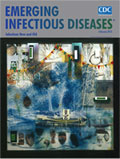
Pneumococcal pneumonia was a complication during previous influenza pandemics but was not evident initially during pandemic (H1N1) 2009. During October 2009 in Denver, Colorado, USA, invasive pneumococcal disease (IPD) and pandemic (H1N1) 2009 peaked simultaneously, which suggests a link. We compared cases of IPD in October 2009 with cases in February 2009, the most recent peak month of seasonal influenza. During October 2009, we observed 58 IPD cases, which was 3× the average number of IPD cases that usually occur in October in Denver. Patients with IPD in October 2009 were younger and more likely to have chronic lung disease than patients who had IPD in February 2009; a total of 10/47 patients had influenza, and 33/53 patients had influenza-like illness. Thus, ≈17%–62% cases of IPD may have been associated with pandemic (H1N1) 2009. Pneumococcal disease prevention strategies should be emphasized during future influenza pandemics.
| EID | Nelson GE, Gershman KA, Swerdlow DL, Beall BW, Moore MR. Invasive Pneumococcal Disease and Pandemic (H1N1) 2009, Denver, Colorado, USA. Emerg Infect Dis. 2012;18(2):208-216. https://doi.org/10.3201/eid1802.110714 |
|---|---|
| AMA | Nelson GE, Gershman KA, Swerdlow DL, et al. Invasive Pneumococcal Disease and Pandemic (H1N1) 2009, Denver, Colorado, USA. Emerging Infectious Diseases. 2012;18(2):208-216. doi:10.3201/eid1802.110714. |
| APA | Nelson, G. E., Gershman, K. A., Swerdlow, D. L., Beall, B. W., & Moore, M. R. (2012). Invasive Pneumococcal Disease and Pandemic (H1N1) 2009, Denver, Colorado, USA. Emerging Infectious Diseases, 18(2), 208-216. https://doi.org/10.3201/eid1802.110714. |
Infection with Campylobacter spp. commonly precedes Guillain-Barré syndrome (GBS). We therefore hypothesized that GBS incidence may have followed a marked rise and then decline in campylobacteriosis rates in New Zealand. We reviewed records for 1988–2010: hospitalization records for GBS case-patients and campylobacteriosis case-patients plus notifications of campylobacteriosis. We identified 2,056 first hospitalizations for GBS, an average rate of 2.32 hospitalizations/100,000 population/year. Annual rates of hospitalization for GBS were significantly correlated with rates of notifications of campylobacteriosis. For patients hospitalized for campylobacteriosis, risk of being hospitalized for GBS during the next month was greatly increased. Three years after successful interventions to lower Campylobacter spp. contamination of fresh poultry meat, notifications of campylobacteriosis had declined by 52% and hospitalizations for GBS by 13%. Therefore, regulatory measures to prevent foodborne campylobacteriosis probably have an additional health and economic benefit of preventing GBS.
| EID | Baker MG, Kvalsvig A, Zhang J, Lake R, Sears A, Wilson N. Declining Guillain-Barré Syndrome after Campylobacteriosis Control, New Zealand, 1988–2010. Emerg Infect Dis. 2012;18(2):226-233. https://doi.org/10.3201/eid1802.111126 |
|---|---|
| AMA | Baker MG, Kvalsvig A, Zhang J, et al. Declining Guillain-Barré Syndrome after Campylobacteriosis Control, New Zealand, 1988–2010. Emerging Infectious Diseases. 2012;18(2):226-233. doi:10.3201/eid1802.111126. |
| APA | Baker, M. G., Kvalsvig, A., Zhang, J., Lake, R., Sears, A., & Wilson, N. (2012). Declining Guillain-Barré Syndrome after Campylobacteriosis Control, New Zealand, 1988–2010. Emerging Infectious Diseases, 18(2), 226-233. https://doi.org/10.3201/eid1802.111126. |
Volume 18, Number 1—January 2012
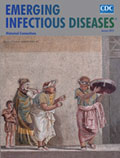
Five cases of intestinal toxemia botulism in adults were identified within an 18-month period in or near Toronto, Ontario, Canada. We describe findings for 3 of the 5 case-patients. Clinical samples contained Clostridium botulinum spores and botulinum neurotoxins (types A and B) for extended periods (range 41–61 days), indicative of intestinal toxemia botulism. Patients’ clinical signs improved with supportive care and administration of botulinum antitoxin. Peanut butter from the residence of 1 case-patient yielded C. botulinum type A, which corresponded with type A spores found in the patient’s feces. The food and clinical isolates from this case-patient could not be distinguished by pulsed-field gel electrophoresis. Two of the case-patients had Crohn disease and had undergone previous bowel surgery, which may have contributed to infection with C. botulinum. These cases reinforce the view that an underlying gastrointestinal condition is a risk factor for adult intestinal toxemia botulism.
| EID | Sheppard YD, Middleton D, Whitfield Y, Tyndel F, Haider S, Spiegelman J, et al. Intestinal Toxemia Botulism in 3 Adults, Ontario, Canada, 2006–2008. Emerg Infect Dis. 2012;18(1):1-6. https://doi.org/10.3201/eid1801.110533 |
|---|---|
| AMA | Sheppard YD, Middleton D, Whitfield Y, et al. Intestinal Toxemia Botulism in 3 Adults, Ontario, Canada, 2006–2008. Emerging Infectious Diseases. 2012;18(1):1-6. doi:10.3201/eid1801.110533. |
| APA | Sheppard, Y. D., Middleton, D., Whitfield, Y., Tyndel, F., Haider, S., Spiegelman, J....Austin, J. W. (2012). Intestinal Toxemia Botulism in 3 Adults, Ontario, Canada, 2006–2008. Emerging Infectious Diseases, 18(1), 1-6. https://doi.org/10.3201/eid1801.110533. |
Results of an accelerated pertussis vaccination schedule for infants introduced in 1990 in England and Wales were examined. Earlier scheduling and sustained high vaccine coverage resulted in fewer reported cases of pertussis among infants, reinforcing the World Health Organization drive for on-time completion of the infant vaccination schedule. As determined by using the screening method, the first dose of vaccine was 61.7% effective in infants <6 months of age, and effectiveness increased with subsequent doses. Three doses of a good whole-cell pertussis vaccine were 83.7% effective in children 10–16 years of age; a preschool booster vaccination further reduced pertussis incidence in children <10 years of age. As in other industrialized countries, surveillance data during 1998–2009 showed that pertussis in England and Wales mainly persists in young infants (i.e., <3 months of age), teenagers, and adults. Future vaccine program changes may be beneficial, but additional detail is required to inform such decisions.
| EID | Campbell H, Amirthalingam G, Andrews N, Fry NK, George RC, Harrison T, et al. Accelerating Control of Pertussis in England and Wales. Emerg Infect Dis. 2012;18(1):38-47. https://doi.org/10.3201/eid1801.110784 |
|---|---|
| AMA | Campbell H, Amirthalingam G, Andrews N, et al. Accelerating Control of Pertussis in England and Wales. Emerging Infectious Diseases. 2012;18(1):38-47. doi:10.3201/eid1801.110784. |
| APA | Campbell, H., Amirthalingam, G., Andrews, N., Fry, N. K., George, R. C., Harrison, T....Miller, E. (2012). Accelerating Control of Pertussis in England and Wales. Emerging Infectious Diseases, 18(1), 38-47. https://doi.org/10.3201/eid1801.110784. |
CME Articles by Volume
